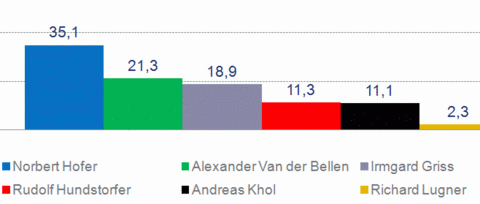
Die Seite www.foresight.at ist gerade im Aufbau. Diese Seite (sora.at) wird nicht mehr gewartet und im Frühjahr 2024 vom Netz genommen.
Elections of the Federal President
of the Republic of Austria 2016: 1st ballot

- Provisional result from 25.4.
- Download charts election day survey (PDF)
- Download election analysis (German, PDF)
- Analysis of the second ballot in May, 2016
Freedom Party candidate Norbert Hofer comes in first in this election with a large margin to Alexander Van der Bellen and Irmgard Griss.
The ORF/SORA/ISA election day survey among 1.210 eligible voters shows that the election was marked by dissatisfaction with the government as well as anger and disappointment with politics in general.
Negative perception of Austria’s development in the past years and high dissatisfaction with the Federal Government
Austria’s development over the past years is judged negatively by an absolute majority of 52%. Only 12% perceive a positive trend, the remaining respondents (34%) perceive no change.
Accordingly, only 3% are currently “very satisfied” with the work of the Federal Government of SPÖ (Social Democrats) and ÖVP (People’s Party), 27% are “rather satisfied”. Over two thirds (68%) on the other hand are not satisfied.
Clearly, Norbert Hofer was most successful mobilizing the votes of the dissatisfied: 55% of those perceiving a negative development of Austria voted for Hofer.
Respondents perceiving a positive development or no change, on the other hand, voted more often for Alexander Van der Bellen.
Anger and disappointment with politics
A vast majority of the Austrian electorate is currently disappointed with politics in Austria (40%) or angry about it (36%). Only 19% are “satisfied”.
Among voters of Norbert Hofer, 63% are angry.
Voters of Irmgard Griss are rather disappointed. Supporters of Alexander Van der Bellen are evenly disappointed or angry.
Further Voting Motives for Norbert Hofer
In the ORF/SORA/ISA election day survey, voters were asked which were the most important motives for their voting decision.
Therefore, most important motives for Norbert Hofer voters were that he „understands the worries of people like me“ (67% very important), his competency (62%), personal liking (61%) and the impression that he is representing the right values (61%).
47% said, Hofer being the Freedom Party candidate was very important for their voting decision.
On the other hand, less than 35% affirmed the motives „Hofer being a moral example”, “ability to mediate conflicts in Austrian politics”, and “representation of Austria abroad”.
Who voted for whom? Voting by socio-demographic groups
The election day survey shows large differences in voting behaviour of various socio-demographic groups.
Gender Gap
If only men had voted, Norbert Hofer would have reached 45% in lead of Alexander van der Bellen with 17%.
Among women on the other hand, Norbert Hofer received 27%, Irmgard Griss 26%, and Alexander van der Bellen 22%.
Differences by age
Van der Bellen appealed especially to young voters (16-29 years). He received 29% in this group.
Norbert Hofer received a similar result in all age groups.
Differences by formal education and occupational status
Among voters with secondary school diploma or tertiary education, two thirds voted for Alexander Van der Bellen or Irmgard Griss.
Among workers, on the other hand, Norbert Hofer came in first with 72%. Social Democrat candidate Rudolf Hundstorfer only received 10 percent in this group which used to be a social democratic stronghold.
Voter transition analysis
The ORF/SORA analysis shows voter transitions from the national election 2013. The main trends are:
- Norbert Hofer mobilizes 86% of Freedom Party voters from 2013 (824.000 votes); 266.000 votes come from Peoople's Party supporters from 2013, 169.000 votes from social democratic party supporters from 2013
- Alexander Van der Bellen mobilizes 69% of the Green voters from 2013 (400.000 votes)
- Supporters of Irmgard Griss are 208.000 People's Party voters from 2013, 122.000 votes come from social democratic party supporters form 2013, 121.000 from Green voters from 2013
Voters transitions Presidential Elections 2016, absolute numbers 1.000 votes (based upon the provisional result from 24.4. including ORF/SORA prognosis of absentee-ballots)
|
|
| Hunds- |
|
| V. d. |
|
SPÖ | 122 | 169 | 402 | 27 | 35 | 202 | 303 |
ÖVP | 208 | 266 | 21 | 379 | 18 | 74 | 160 |
FPÖ | 27 | 824 | 7 | 32 | 10 | 16 | 45 |
Greens | 121 | 4 | 2 | 6 | 3 | 400 | 47 |
Stronach | 95 | 122 | 5 | 3 | 5 | 5 | 33 |
NEOS | 112 | 8 | 1 | 2 | 4 | 82 | 24 |
Others '13 | 82 | 61 | 11 | 13 | 8 | 45 | 42 |
Non-Voter '13 | 44 | 49 | 13 | 13 | 16 | 84 | 1471 |
Sum '16 | 810 | 1504 | 462 | 474 | 99 | 908 | 2125 |
Beispiel: 122.000 SPÖ-voters (social democrats) from the national election 2013 voted for Irmgard Griss, 169.000 voted for Norbert Hofer etc.
